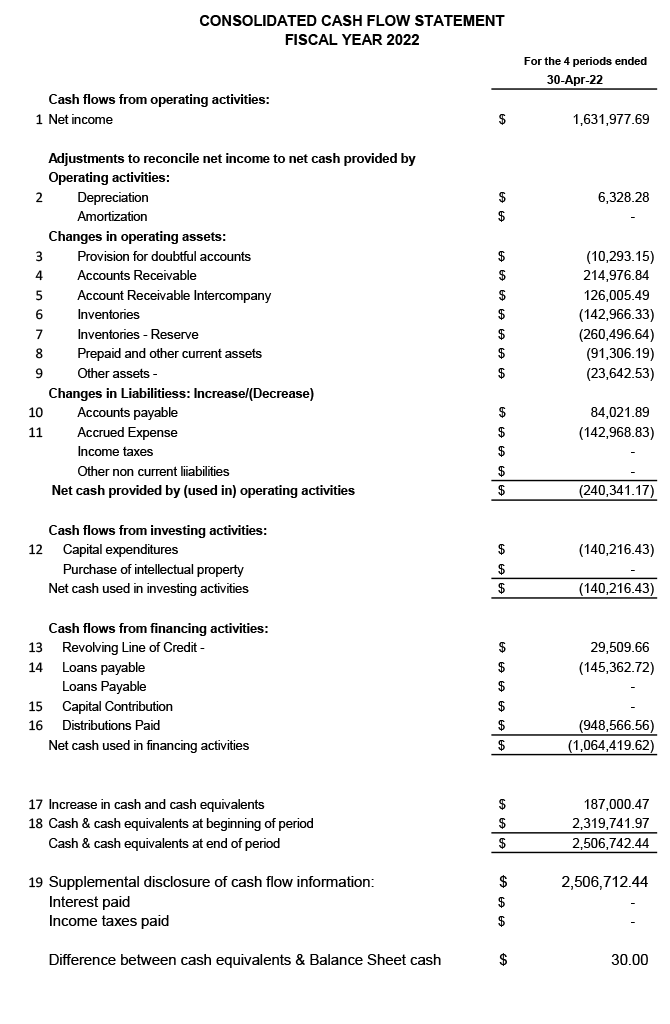What Is a Cash Flow Statement?
A cash flow statement breaks down the various types of inflows and outflows of cash (and cash equivalents) that a business experiences over a period of time. It can help you and other stakeholders clearly see how your business earns or spends cash, and it can provide valuable insight into your company financials. It also can help you spot business trends that can improve your overall business decision-making and make better use of your profits.
A cash flow statement breaks down the various types of inflows and outflows of cash (and cash equivalents) that a business experiences and is arguably one of the most important financial statements a business can generate. Learning how to prepare and manage cash flow statements can be quick and impactful. It can help you and other stakeholders clearly see how your business earns or spends cash, the amount of cash lost or gained, and it can provide valuable insight into your company’s financials. It also can help you spot business trends that can improve your overall business decision-making. Learning how to do a cash flow statement is invaluable to small business owners.
So, what goes in cash flow statements, and how do you prepare a cash flow statement that will provide the most benefit for your business? Here are the essential things to know in order to put an effective statement of cash flow together.
What Goes Into the Preparation of a Cash Flow Statement?
What time period your cash flow statement covers is entirely up to you. Some companies prepare cash flow statements annually—covering their full fiscal year—while others prepare them quarterly or even monthly. The frequency you choose should depend on how your business will use the statement and whether more regular reporting will provide a greater benefit.
There are two main methods for preparing a cash flow statement to consider: the direct method and the indirect method. While the indirect method is more common, the better choice between the two will depend on how much detail you need to include in your statement and how much time you are willing to devote to the process in order to improve your short-term and long-term decision making. (See below for a further discussion about choosing the right method for your financial reports.)
It’s also important to understand which types of financial transactions should be reflected in the statement—and which should not. Only inflows and outflows of cash and cash equivalents should be accounted for in the cash flow statement in order to calculate accurate net cash flow. Noncash transactions that do not directly affect cash receipts—such as depreciation or bad debt write-offs—should not be included.

Cash Flow Report Breakdown
When it comes to calculating cash flow and determining what goes into a cash flow statement, there are three types of cash flows you will want to break out in order to gain the most value and insight from your cash flow statement:
- Operating activities cash flow. This is the money your business generates and spends on typical, day-to-day operating activities, such as selling products and services or paying rent and employees. Cash flows from operations are integral to your cash flow statement.
- Investing activities cash flow. This is the money spent on and generated from market securities, long term assets, and other financial instruments over the reporting period. It could be from buying or selling major equipment or property, or other related purchases or sales, for example.
- Financing activities cash flow. Financing activities include the money that moves between a company and its owners, investors, and creditors, such as by issuing equity or debt.
You also may want to include an “other activities” section for any type of cash flow that doesn’t fit into these three main activities. Each section should include line items that break out the various types of cash flow pertaining to that activity, so no cash payments are missed.
How to Prepare a Cash Flow Statement
Before you start working on your statement, determine whether the indirect method or the direct method to prepare a cash flow statement makes the most sense, given your needs. Keep in mind that the method you select will only affect the operating activities section of your statement—as the investing and financing activities sections will look the same regardless of the method used.
Each method has its advantages and disadvantages. The indirect method is more common, for example, because it’s generally simpler and less time-consuming to perform. But the direct method provides greater detail about your company’s cash situation and, in turn, more potentially valuable insights.
Indirect Cash Flow Method
The indirect method is based on accrual basis accounting—which means revenues and expenses are counted when they are incurred, not when money actually changes hands. Most companies use the accrual basis of accounting method, which is partly why this method is so popular.
For the operating activities section of the cash flow statement, the indirect method involves first showing the company’s net income (which should be found easily on your company income statement). You then show any noncash inflow or outflow adjustments that need to be made in order to calculate the total operating activities cash flow. Common adjustments, for example, include:
- Depreciation (which must be added back to the net income because it does not count as cash flow)
- Accounts payable
- Accounts receivable
- Inventory expenses (which must be subtracted from the net income because they are considered a cash outflow)
- Working capital changes
Direct Cash Flow Method
The direct method relies on cash basis accounting—meaning revenues and expenses are counted when actual cash receipts and payments are made during the reporting period.
The direct method generally takes more time and number-crunching because you are subtracting actual cash outflows from inflows rather than simply adjusting the net income. Common line items using the direct method include:
- Customer receipts
- Payments to suppliers
- Payments to employees
- Interest and dividends received
- Income tax payments
While breaking out each type of cash receipt or payment takes time, this method offers more detail and visibility into your company’s finances. For example, it can show how much cash was spent during the reporting period on employee payroll or merchandise—or the exact dollar value of customer sales—rather than having those individual cash flow sources grouped together in “net income.”

That said, there are additional potential complexities to choosing the direct method to prepare cash flow statements. For one, since most companies use accrual basis accounting, the indirect method more naturally fits with their current accounting practices. Moreover, the Financial Accounting Standards Board (FASB) requires companies using the direct method to also provide a “reconciliation” that shows how their net income would be adjusted to net cash (essentially using the indirect method) on a separate schedule.
Most accounting standard-setting entities (including FASB) prefer the direct method, though, because of the higher level of insight it provides. If you choose to go the direct method route, you’ll want to start regularly tracking your cash inflows and outflows in the way you’ll be reporting it—so that putting together the cash flow statement won’t be too much of a burden.
You can use accounting software such as Intuit QuickBooks, Zoho, or FreshBooks to keep tabs on your cash flow and more easily assemble the cash flow statement.
How to Interpret a Cash Flow Statement
Your cash flow statement not only provides insight into how cash is flowing in and out of your operation. It also tells you what stage your business is in, whether you’re a startup or in a growth phase. Analyzing and comparing your year-over-year cash flow statements can help you get insight into the risk of your company. This helps you determine which areas of your small business are contributing to the growth of your company.
It’s also important to note that if you recently made a large investment, you may have a negative cash flow for a certain amount of time.
Positive Cash Flow
If your company has a positive cash flow, that means more funds are coming in than going out. Ideally, this is what you want for your business. Positive cash flows allow you to pay off debts and invest back into your business easier. It’s also important to note that a positive cash flow doesn’t always mean your business is making a profit.
Negative Cash Flow
Negative cash flows mean your cash outflow is higher than your cash inflow. This doesn’t always mean your small business lost profits. For example, an acquisition of another company that creates future growth can cause a negative cash flow from operations for a certain period of time.
Cash Flow Statement Example
You can learn more about cash flow statements by looking through the example below. This statement shows $1,631,977.69 in income, with cash only increasing $187,000.47. Why is that? This report reconciles what a company shows as net income to what’s ending up in their bank account because there is a significant difference between the two. That’s because there are a number of transactions (capital expenditures, loan payments, distributions, etc.) that impact cash but are not reflected in an income statement.

Cash Flow vs. Balance Sheet vs. Income Statement
Cash flow statements break down different types of inflows and outflows of cash and cash equivalents over a period of time for your small business. However, this isn’t the only important financial statement you’ll need for your small business. You’ll also need income statements and balance sheets.
Income statements are also known as profit and loss statements. This financial document reports your small business’s revenue and expenses, which gives you insight into your financial performance. Each income statement showcases a certain accounting period.
Your balance sheet lays out your assets, liabilities and owner equity in one document. This gives you a good look at your financial position and health for a certain period of time.
How to Use Your Cash Flow Statement
So, now that you know how to do a cash flow statement, how do you make the most of the statement once it’s finished?
It can be used in multiple ways and presented to different types of interested parties. For example, you should use your cash flow statement internally to better understand how and when your business generates and spends cash. In turn, it can be invaluable for making budgeting decisions and predicting your cash situation in the future.
You also can give it to creditors looking to gauge your company’s working capital, liquidity, and overall financial health when determining whether to provide financing and how much. And you can give it to prospective and current investors looking to evaluate your company’s financial well-being and determine its worthiness as an investment.
As you look to grow and evolve your company, learning how to prepare cash flow statements can be a great way to help yourself and other interested parties evaluate how your business is performing from a cash perspective—and ultimately make better business decisions.






Hi
Thank you for a wonderful explanation for preparing CF statement and kindly, may I ask why the accrued expense is negative in the operating activities.
Your further explanation is highly appreciated.
Can anyboby explain how to calculate the purchase of property, plant and equipment in a indirecct method and also the calculation of proceed of sale on properties??
I would need much more information from you to answer that question and I don’t believe this forum is the right place. You should probably discuss this with an accountant or lawyer.
Nice post and information for sharing.
Thanks! We’re glad you liked it!
kindly teach me from trial balance to Financial Statement
Sure! All of your transactions – cash receipts, payments, invoices, etc. – are recorded in your general ledger. That’s your “diary” of your business. The trial balance just sums up the general ledger so it doesn’t include all the detail. A financial statement then further groups the accounts on the trial balance into a balance sheet and income statement.
Please how will I calculate 1. cash paid from investing activities
2.cash paid from operating activities
3. cash paid from financing activities
With due respect may you email me the formulas of how to calculate the above types of cash flow statements.
These calculations are simply done by taking the difference between your balance sheet accounts (except your cash balances) at the beginning of the year and the most current period. Then categorizing those difference under investing (buying capital equipment), operating (receivables and payables) and financing (getting/paying loans). When you add up all the difference it should come to the difference in your cash balance from the beginning of the year to the current period.
HI
Respected.
i want to know about the cash flow statement of a educational institutions like University by using indirect method.
For Paul
the cash flow statement is showing past transactions, so the bill payments you made should be reflected in the difference between beginning and ending accounts payable. hope that helps.
How do you calculate bill payments on a cash flow statement ? Thank You.